|
| |
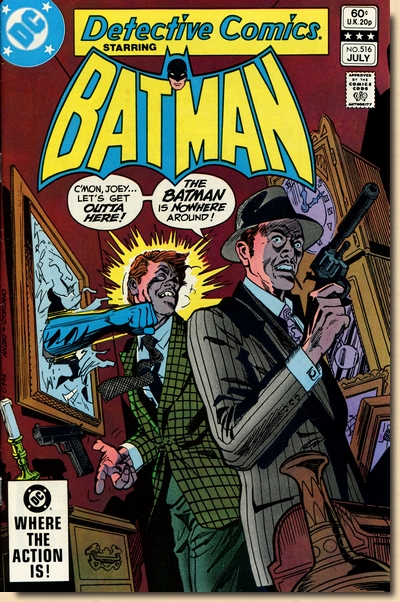 |
|
(JULY 1982)
"Final Exams!"
("The Academy of Crime
Part II")
(18 pages)
Part 2 of 2
(continued from Detective Comics
#515)
Cover pencils - Ross Andru
Cover inks - Dick Giordano
Story
- Gerry Conway & Paul
Kupperberg
Art - Don Newton
Inks - Frank Chiaramonte
Colours - Adrienne Roy
Lettering - Ben Oda
Editor - Dick Giordano
Second feature: Batgirl,
"Sleep while the Serpent
smiles!"
(7 pages)
"Batcave" letter page
(1 page)
REPRINT - Tales of the
Batman: Gerry Conway #3 (2019)
LOCATIONS - Hollywood, Gotham City
VILLAINS - Academy of Crime
NOTES - Continued plot and
story crossovers between Detective
Comics and Batman
|
|
|
| |
|
| |

WELCOME TO THE ACADEMY
OF CRIME,
THE HOLLYWOOD BASED INSTITUTE OF
HIGHER LEARNING FOR
SOCIETY'S LOWER
STRATA.
WOULD-BE CRIMINALS THE
COUNTRY OVER COME HERE
TO LEARN THE INS-AND-OUTS OF LARCENY AND
MURDER.
HIS NAME -- FOR PURPOSES
OF ENROLLMENT
-- IS MATCHES MALONE
--
-- HIS TRUE
IDENTITY -- FOR PURPOSES OF LIFE'S WORK
-- IS THE BATMAN.

|
|
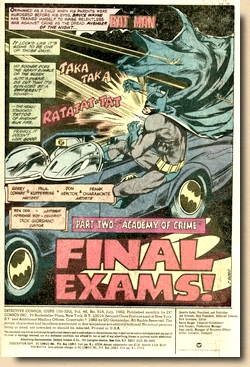 |
|
|
| |
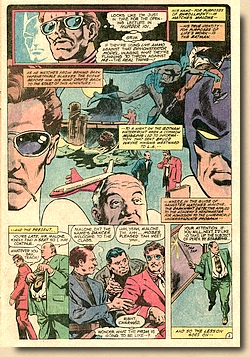 |
|
PLOT SUMMARY
Bruce
Wayne's mission - which has sent him out to
Hollywood in the guise of "Matches"
Malone (Detective Comics #515) - to infiltrate and smoke out
the so-called "Academy of Crime" is
gathering speed as he has been admitted to the
institute by its founder and spiritus rector,
The Headmaster.
However,
as "Matches" Malone follows class upon
class - all of which seem to have "killing
Batman" as their sole subject matter - his
classmates seem to grow ever more suspicious
about "Matches".
Back in Gotham,
"Boss" Thorne - who is pulling the
behind-the-scenes strings in Gotham City in a big
way - is upping the pressure on Monroe, the
publisher of Picture News Magazine, who
has so far failed to get hold of the photographs
which Vicki Vale has announced will unveil and
prove the secret identity of Batman. Monroe's
fear (as he is subjected to the threats of
"Boss" Thorne should he fail again) is
heightened further by puzzling additional
outbursts by the mob kingpin - who, unbeknownst
to Monroe - once again sees an apparition of a
dead man who has come back to haunt him: Hugo
Strange...
|
|
| |
| Monroe in
turn tells Vicki Vale back at the editorial offices that
he wants the Batman photographs now, but Vicki responds
to his threats by walking out of him. Heading off to
Alfred, she tells him that she can now only give him two
more weeks to prove that Bruce Wayne is not the Batman. |
| |
| Meanwhile,
back in LA, a stickup has Bruce Wayne
swap his "Matches" Malone
identity for that of the Caped Crusader
and swing into action. However, this does
no good towards dispersing the doubts and
suspicions amongst his classmates, and
the next day Bruce Wayne finds that The
Headmaster has set him up - to
impersonate the Darknight Detective in
class and to be done away with. As
the confrontation escalates, Batman takes
centre stage in a Hollywood backlot and
calls an end to the show of the Academy
of Crime as well as its Headmaster.
And finally, back in
Gotham City again, former Commissioner
James Gordon and private detective Jason
Bard seal their partnership in Bard's
agency, and Gordon vows to bring down the
corrupt workings which have put mayor
Hamilton Hill and his newly assigned
police commissioner Peter Pauling in
place.
|
|
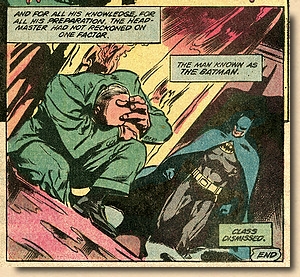 |
|
|
| |
REVIEW & ANALYSIS
Readers who only followed Detective
Comics (but not Batman) could easily have
gained the impression in June and July of 1982 that DC
was downsizing the crossover idea to simply having
general subplot elements point to the other title, but
with no need to actually have to pick up and read both Detective
Comics and Batman. After all, Detective
Comics #516 continued and wrapped up the story
revolving around the Academy of Crime and Batman's
excursion to Hollywood which had started in the previous
issue of that very same title.
|
| |
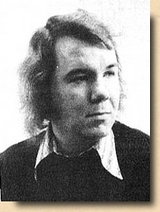
Gerry
Conway
(*1952)
|
|
Readers who
did read both titles, however, got the bigger
picture and realised how deceivingly simple
things appeared to be for those reading
exclusively Detective Comics. In
reality, writer Gerry Conway and editor Dick
Giordano were in the process of expanding the
crossover formula for Detective Comics and
Batman. Not
only would the various subplots - which were
mostly tied to individual characters - continue
over several issues of both titles, but now the
mainframe story itself would carry on over
several issues of Batman and Detective
Comics.
The reason why this
wasn't obvious to those reading only the latter
title straight away was the fact that Conway was
ingeniously setting up Batman and Detective
Comics in a parallel narrative as opposed to
the previously applied sequential stories.
|
|
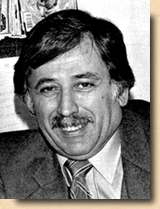
Dick
Giordano
(1932 - 2010)
|
|
| |
| As a
result, Detective Comics #515 and #516 were focused on the West Coast
(and therefore Batman on the trail of the Academy of
Crime), whilst Batman was showing readers what
was happening at the same time on the East Coast without
the Batman being present. As a consequence, readers of Detective
Comics only were in the same position as Batman -
completely unaware of the uncanny events back in Upstate
New York involving Robin and vampires, as depicted in Batman #349. |
| |
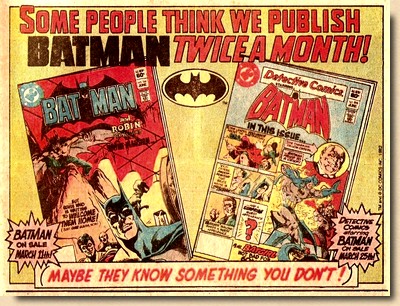
In-house ad from Detective
Comics #515
|
|
An
interesting narrative technique not often found
applied to two comic book titles (en lieu of
having two features within the same issue of a
title), it also reinforced Conway's handling of a
supernatural villain in the most realistic way
possible, in order to ensure that the world of
Batman and that of vampires were compatible.
By
going there without a rush and one step at a time
- by having Robin and Batman separate and being
afflicted individually - Conway managed to roll
out a stark and chilling tale which remained true
to the Batman's overall closeness to what seemed
just possible in reality.
"One of the
reasons why Batman is my favorite super-hero
is because he's not really a super-hero. For
me, it was always hard to get by radioactive
spiders or someone who came from another
planet." (Giordano in Cooke, 1998)
|
|
| |
| So those readers who purchased Detective
Comics #516 but not the same month's Batman
#349 really had no idea what was coming their way - but
they would find out soon enough, and DC made sure and
certain to put the message across through in-house
adverts and tried to get readers to pick up both titles.
|
| |
| On
its own, Detective Comics #516
concludes a two part Batman story which
has its merits but somehow never seems to
reach its full potential. Los Angeles and
the studio backlots of Hollywood would
seem to hold a lot of potential for some
highly atmospheric Batman yarn, but this
never really works - mainly because the
prime identity for Bruce Wayne in LA is
"Matches" Malone rather than
the Darknight Detective. In addition, the
Academy of Crime seems to operate a day
school schedule, which results in fewer
night time scenes - making the Batman
feel even more out of his usual waters. But then the strong side
of Detective Comics #516 lies
less with what is actually happening in a
big way but more with what is slowly
being set up to happen in the future.
There is a lot of plot suspense building:
What mysterious forces have gotten hold
of Robin? Can Alfred stop Vicki Vale from
revealing that Bruce Wayne is Batman?
What is in store for James Gordon as he
joins forces with PI Jason Bard?
|
|
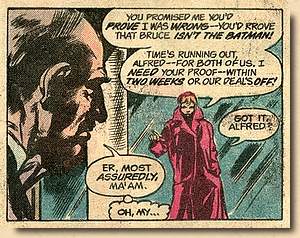 |
|
|
| |
| It all
flows flawlessly from the pen (or maybe typewriter) of
Gerry Conway, and it works perfectly thanks to Don
Newton's artwork which provides the visuals to carry and
maintain that sense of impending events, and possibly
even doom. |
| |
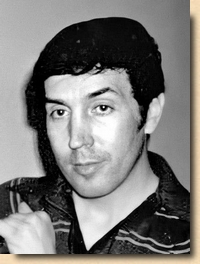
Don Newton
(1934 - 1984)
|
|
Donald
"Don" L. Newton pursued
a career as an arts teacher
before becoming a professional
comic book artist at the age of
40,
starting out with background
artwork for Marvel's Giant-Size
Master of Kung Fu #1
(September 1974) and providing
full pencils for a number of
titles from the Charlton Comics
(where he was soon assigned to The
Phantom). In early 1977 Don
Newton started to work for DC,
and there made first contact with
the Batman Universe in Batman
Family #13 (September 1977),
although "The Man Who Melted
Manhattan!" did not feature
the Darknight Detective himself. Detective
Comics #480 (November 1978)
saw Don Newton's first actual
Batman story, entitled "The
Perfect Fighting Machine"
and written by Denny O'Neil. His
pencils were inked by Dave Hunt
and he was credited as a
"guest penciller" -
who would return
immediately with the next issue
of Detective Comics
(#481).
As of
February 1982, Don Newton was the
major contributor together with
Gene Colan for the artwork
featured in Gerry Conway and Dick
Giordano's "continuous
Batman crossover" running in
Batman and Detective
Comics (no single artist
would have been able to
consistently carry the workload
of two Batman titles per month
over a prolonged period of time).
|
|
|
|
| |
| Don Newton's artwork
was rarely anything but perfection. He was in
absolute command of any action scenes and -
especially important for Detective Comics
#516 - a master at visualizing the suspense and
atmosphere of things to come and, most likely,
the threat of impending doom. |
|
| |
Just how
important Newton had been for DC and how much his
work had been appreciated could be seen in editor
Dick Giordano's obituary which DC published in
the "MEANWHILE..." column
following Newton's early passing in 1984.
"Although his work was
known by everyone in the business, along with
most others, I never got to know Don Newton
very well. He lived and worked in his home in
Arizona and hated big cities, so he didn't
like coming to New York very much (...) Don
Newton, the artist, is another story, though
(...) His penciled pages were, in and of
themselves, works of art. They were complete
when they left his drawing table. One did not
have to visualize the finished inked page
(...) When Don's work arrived at the office,
it was an event. We crowded around to have a
look and to marvel at the talent. He never
disappointed. Don was a true
professional."
|
|
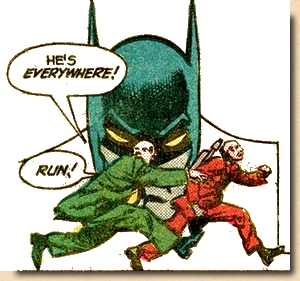
|
|
| |
| Don Newton's career in comics was
tragically cut short, but the legacy of his fine
contribution to the comic book medium lives on
through the body of his work (extensive examples
of which can be found on the (now archived)
dedicated website The Art of Don Newton). |
|
| |
| Overall, the two part Academy
of Crime story displays Gerry Conway's solid
storytelling, pacing and characterization (although The
Headmaster does remain rather two-dimensional
throughout), in addition to which Don Newton's artwork is
crisp and flows smoothly. RECOMMENDED READING - Whilst not being a top notch
Batman story, it is a must read within the context of the
Batman versus the vampire Monk story arc.
|
| |
|
| |
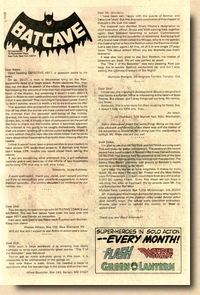 |
|
TRIVIA
One
thing that always set DC apart from its rivals
Marvel was how the company and its editors would
communicate with its readers, and tthis was still
very noticeable in the early 1980s. For starters,
unlike the House of Ideas' "Bullpen
Bulletin", regular communication pieces at
DC (such as "DC Currents" or
"Meanwhile...") would never really
become a permanent fixture and come and go -
which also meant that the only regular line of
communication were the letters pages published in
individual titles.
But
even there, the difference between DC and Marvel
could at times not be more accentuated - as
indeed illustrated by the letters page of Detective
Comics #516, with readers addressing the
editor as "Dear Editor" and "Dear
Dick", but also as "Dear Mr.
Giordano". Giordano was in some way trying
to loosen up things by using a regular tagline to
end the letters page ("Thank you and good
afternoon!"), but again this was nothing
like Lee's "and don't forget to take a
turtle out to tea!".
The
bottom line was quite simple: the two publisher's
had a completely different house style.
|
|
| |
|
| |
|
| |
| |
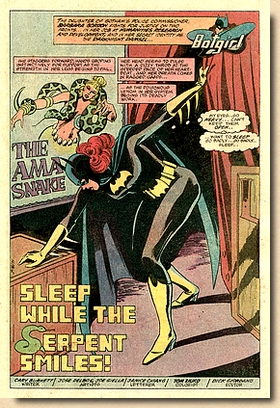 |
|
BACK-UP FEATURE
Harking
back to the days of the 1930s and 1940s when Detective
Comics contained several features within its
68 pages, the back-up feature remained a
tradition long after the page count had dropped
substantially, and as Detective Comics
#400 (June 1970), Bat-Girl was installed as the
regular back-up feature - a role she fulfilled
until she was replaced by Green Arrow as of Detective Comics #521 (December 1982).
When
first introduced in Batman #139 (April
1961), Bat-Girl was originally Betty Kane, the
niece of Kathy Kane, a.k.a. Batwoman, before the
character was reprised by Barbara Gordon,
daughter of police commissioner James Gordon, in Detective
Comics #359 (January 1967).
The
Barbara Gordon Bat-Girl immediately caught on
with readers, building a loyal fan base over the
years. However, by the time Detective Comics #516
was published, her stories displayed a distinct
tendency of loose scripting and artwork, a
deficiency that was felt all the more as the main
Batman stories went exactly the other way,
displaying consistently top quality work issue
after issue. It was therefore probably no big
surprise that Bat-Girl would be replaced by the
end of the year by Green Arrow. When the end came
for the Emerald Archer's back-up feature run in Detective
Comics #567 (October 1986), the back-up
feature itself was dropped from the pages of Detective
Comics.
|
|
| |
|
| |
| |
COMMENTS FROM THE
BATCAVE
|
| |
| The letters page published in
Detective Comics #516 was
full of praise for the Batman/Detective Comics
"crossover", clearly indicating to DC that they
were on to something good. As for the story featured in Detective
Comics #516, the reactions (and praises) would be
published in Detective Comics #521. |
| |
 |
|
"DETECTIVE
COMICS #516 was a masterpiece!" (Jerry
Hooten, Lemon Grove CA)
"DETECTIVE COMICS #516
was basically a very enjoyable, well though-out
and well executed
"Batman-clobbers-the-bad-guys" story
(...) Honestly, the only boring thing about the
once terminally dull Batman strip is the
consistent quality that marks every story."
(No name or address given)
|
|
| |
"Well
handled and full of suspense"
(Glenn Dressler, Kankakee IL)
"Great Batman
thriller" (Kent A. Phenis,
Indianapolis IN)
(from the letters page of Detective
Comics #521)
|
| |
|
|
|
| |
|
| |
|
| |
BATMAN and all related elements are
the property of DC Comics, Inc. TM and © DC
Comics, Inc.
The illustrations presented here are
copyright material. Their reproduction for
the review and research purposes of this
website is considered fair use as set out by
the Copyright Act of 1976, 17
U.S.C. par. 107.
|
|